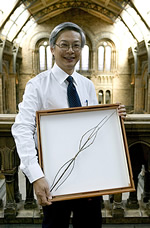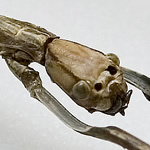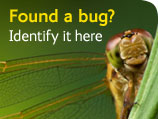World's longest insect revealed
The world's longest insect, a 56.7 cm long stick-insect from Borneo, has joined the Museum's collections. The spectacular specimen of Chan's Megastick, Phobaeticus chani, was donated to the Museum by Datuk Chan Chew Lun.
Only 6 specimens

Datuk Chan Chew Lun donates this spectacular specimen to the Museum.
The species was given its scientific name in 2008. Only six specimens have been found so far, all from the Malaysian State of Sabah on the island of Borneo. Datuk Chan obtained the first and largest known specimen (a female) from a local collector.
Previous record-holders
This specimen is more than 1cm longer than the previous record holder for overall length, which was a stick-insect called Phobaeticus serratipes found in Malaysia and Indonesia.
Not including its legs, Chan's Megastick measures 35.7cm, winning the insect world record for the longest body. It beats the previous title-holder, Phobaeticus kirbyi, from Borneo, by 2.9cm.
'We've known about both of the previous record holders for over a hundred years, so it is extraordinary that an even bigger species has only just been discovered,' said Dr George Beccaloni, stick-insect expert at the Museum.
Hard to find

Close-up of head of stick-insect Chan's Megastick
Although virtually nothing is known about the biology and ecology of this super-sized insect, it is thought that it probably lives in the canopy of the rainforest, making it especially hard to find.
'It is a sad thought that many other spectacular insect species are disappearing as their habitats are destroyed, before we have even had the chance to find and name them,' George said.
Amazing eggs

Egg of the Phobaeticus chani stick-insect. It has wing-like extensions that allow it to drift in the wind.
In addition to its size, its eggs may also be unique in the insect world. Each egg capsule has wing-like extensions on either side like a miniature golden snitch, allowing them to drift in the wind when the female drops them, thereby helping the species to spread.
3000 species
There are around 3000 known species of stick-insect, mainly living in the tropics and subtropics. Although they do not naturally occur in Britain, three species from New Zealand have become established in the south-west of England and the Isles of Scilly.
British scientist Dr Philip Bragg described and named this stick-insect and the details were published in the journal Zootaxa.
Toolbox

In World War II the Museum was used as a secret base to develop new gadgets for allied spies, including an exploding rat!

